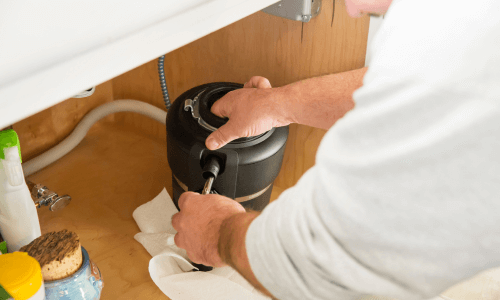
How to unclog garbage disposal with standing water
A clogged garbage disposal with standing water can be a frustrating and inconvenient problem. It often indicates a blockage or issue within the disposal unit or the connected plumbing. Addressing this issue promptly is crucial to prevent further complications and ensure your kitchen plumbing functions smoothly. In this detailed guide, the experts at Local Plumber in Florida will walk you through the steps to unclog garbage disposal with standing water, including when to seek professional help.Understanding the Garbage Disposal System
Before diving into solutions, it’s helpful to understand how a garbage disposal works and what might cause it to clog:1. How a Garbage Disposal Works
-
- Grinding Mechanism: The disposal unit uses a grinding mechanism to chop up food waste into smaller particles.
-
- Discharge Pipe: Ground waste and water are then expelled through the discharge pipe into the home’s plumbing system.
- Blades and Impellers: The disposal contains blades and impellers that help break down and push food waste through the system.
2. Common Causes of Clogs
-
- Food Waste: Excessive amounts of food, particularly starchy or fibrous foods, can clog the disposal.
-
- Non-Food Items: Objects like utensils, dishcloths, or plastic can get caught in the disposal.
-
- Grease and Oil: Pouring grease or oil down the disposal can lead to build-up and clogs.
- Foreign Objects: Hard objects like bones or fruit pits can damage or block the disposal.
Step-by-Step Guide to Unclog Garbage Disposal with Standing Water
1. Safety First
-
- Turn Off Power: Ensure the garbage disposal is turned off before starting any work. Unplug the unit or turn off the power at the circuit breaker to avoid accidents.
- Wear Gloves: Protect your hands with gloves to prevent injury and contamination.
2. Remove Standing Water
-
- Use a Container: Place a container or bucket under the sink to catch any standing water when you open the drain.
- Scoop Out Water: Carefully remove the standing water using a cup or small container. Dispose of it in a sink or toilet, not down the disposal.
3. Check for Visible Blockages
-
- Inspect the Disposal: Look inside the disposal unit for any visible obstructions. Use a flashlight if necessary.
- Remove Debris: Use tongs or pliers to carefully remove any visible debris, such as food scraps or foreign objects. Do not use your hands directly, as the disposal blades may still be sharp.
4. Manually Rotate the Blades
-
- Locate the Hex Key: Many garbage disposals come with a hex key (Allen wrench) that can be used to manually rotate the blades.
-
- Insert the Hex Key: Insert the hex key into the hole at the bottom of the disposal unit (usually located at the center).
- Rotate: Turn the key back and forth to free any stuck blades or debris. If the blades move freely, the obstruction may be cleared.
5. Use a Plunger
-
- Position the Plunger: Place a plunger over the sink drain, ensuring it creates a seal.
- Plunge Firmly: Use firm, consistent plunges to try and dislodge the clog. This method can help push debris through the pipes and improve drainage.
6. Use Baking Soda and Vinegar
-
- Add Baking Soda: Pour a cup of baking soda into the disposal.
-
- Add Vinegar: Follow with a cup of vinegar.
-
- Wait: Allow the mixture to sit for 15-30 minutes. The chemical reaction can help break down debris and clear minor clogs.
- Flush with Hot Water: Rinse the disposal with hot water to help clear any remaining debris.
7. Check the Drain Pipe
-
- Inspect the Pipe: Look for any blockages in the drain pipe connected to the disposal. Use a flashlight to get a better view.
- Remove and Clean: If accessible, remove the drain pipe and clean out any debris. Be prepared for water spillage and have a bucket handy.
8. Reset the Disposal
-
- Locate the Reset Button: Find the reset button on the bottom of the disposal unit. It is usually a red button.
- Press the Reset Button: Press the reset button to restore power to the unit. This step can help resolve any overload issues that may have contributed to the clog.
9. Run the Disposal
- Turn On the Power: Restore power to the disposal unit by plugging it back in or turning on the circuit breaker.
- Run Water: Turn on the water and run the disposal to see if it is functioning properly. Check for any leaks or unusual noises.
When to Call a Professional Plumber: Unclog Garbage Disposal
If the DIY methods do not resolve the issue or if you encounter any of the following situations, it’s time to call a professional plumber:1. Persistent Clogs
-
- Situation: If the garbage disposal remains clogged despite your efforts to clear it.
- Why Call a Pro: Persistent clogs may indicate a more severe blockage or issue that requires professional tools and expertise.
2. Unusual Noises
-
- Situation: If you hear grinding, banging, or other unusual noises when running the disposal.
- Why Call a Pro: Unusual noises can signal damaged blades, motor issues, or other internal problems that need professional repair.
3. Leaks or Water Damage
-
- Situation: If you notice leaks or water damage around the disposal area.
- Why Call a Pro: Leaks can be indicative of damaged seals or pipes that need professional attention.
4. Electrical Issues
-
- Situation: If the disposal unit fails to turn on or experiences electrical problems.
- Why Call a Pro: Electrical issues can be dangerous and require a licensed electrician or plumber to address.
5. Foreign Objects
-
- Situation: If you suspect that a hard object or utensil is stuck in the disposal.
- Why Call a Pro: Removing foreign objects often requires professional tools and expertise to avoid damaging the disposal unit.
Preventive Measures to Avoid Future Clogs: Unclog Garbage Disposal
To prevent future clogs and maintain your garbage disposal, consider these tips:1. Avoid Certain Foods
-
- Grease and Oil: Never pour grease or oil down the disposal. Instead, dispose of them in a container and throw them away.
-
- Fibrous Foods: Avoid disposing of fibrous foods like celery, corn husks, or onion skins, which can wrap around the blades and cause clogs.
- Hard Objects: Do not put hard objects like bones, fruit pits, or shells down the disposal.
2. Run Water While Operating
- Continuous Water Flow: Always run cold water while using the disposal to help flush food particles and prevent clogs.
3. Regular Cleaning
-
- Use Ice Cubes and Salt: Occasionally run ice cubes and salt through the disposal to help clean the blades and remove odors.
- Clean the Splash Guard: Regularly clean the splash guard and the area around the disposal to prevent buildup.
4. Schedule Maintenance: Unclog Garbage Disposal
- Professional Inspections: Schedule regular maintenance and inspections with a professional plumber to ensure your disposal is in good working condition and to catch any potential issues early.
A clogged garbage disposal with standing water can be a manageable issue with the right approach. By following the steps outlined in this guide, you can attempt to resolve the problem yourself and restore proper drainage to your kitchen sink. However, if DIY methods don’t work or if you encounter more complex issues, don’t hesitate to seek professional help. For expert plumbing services and advice in Florida, trust the experienced team at Local Plumber. We’re here to help with all your plumbing needs, from unclogging disposals to comprehensive solutions for all your home’s plumbing challenges. Email us at services@local-plumber.com or call us at (833) 247-7667 (POOP).
Related Tags:




